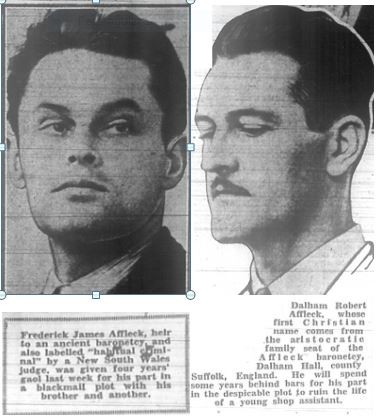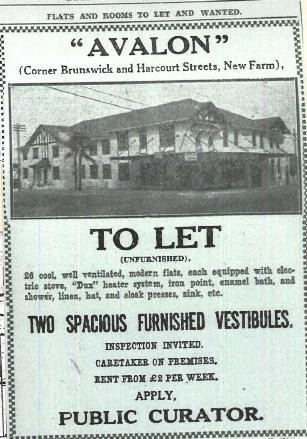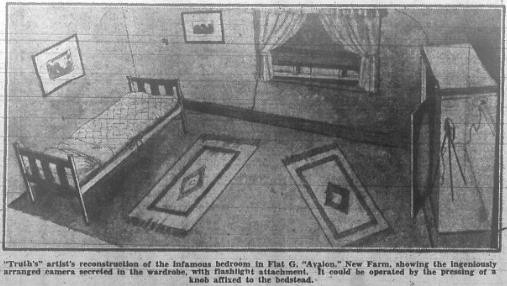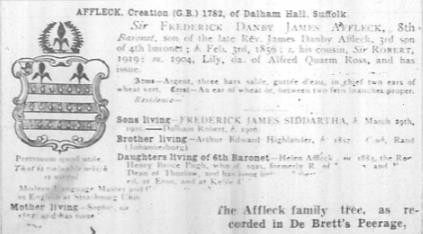In July 1937 the Affleck brothers were tried on charges sufficiently lurid to bring a crowd of people from across the social range to the Supreme Court in Brisbane. The brothers were Frederick James Siddartha Affleck and Dalham Robert Affleck.

The Affleck brothers. Truth, 5 December 1937 p 23.
They were accused of running a “vice club” for “jaded businessmen”. It was very popular apparently, judging from the many photographic negatives of the events. The brothers added profit to their enterprise by running a blackmail business on the basis of these photographs. The scheme came to the attention of the police and courts when a young man was taken to Flat G of the Avalon flats in New Farm, knocked unconscious, photographed in a compromising position, and then threatened with blackmail. He went to the police.
Why the case was so compelling
There were several interesting dimensions to this case: the potential exposure of Brisbane identities, the criminal history of the brothers, the colourful backdrop of the Avalon flats, and the aristocratic background of the Affleck family.
The issue of what names might be revealed piqued interest. It was claimed that some businessmen disappeared from Queensland because of their possible exposure. As it turned out, the Afflecks did not reveal names. What was revealed was the habitual criminal record of Frederick Affleck, heir to the Affleck baronetcy, and his collusion in this case with his brother who, it was suggested, might have been a competent playwright. They both received four year jail sentences.
The Avalon flats
The Avalon belonged to the busy interwar flat building period in New Farm. Hall and Prentice designed 26 small, one-bedroomed flats identified by the letters A-Z. Later, the firm would design the City Hall. The Avalon is still in existence. It has housed a range of tenants, from Margaret McCawley, the widow of Queensland’s youngest Chief Justice, to a disparate group of artists, criminals and working people. It has warranted a book titled Avalon: art & life of an apartment building, edited by Ricardo Felipe, covering its characters and colourful stories, and a painting by Leslie Edwards, both held at State Library of Queensland. An illustration at the time of the Affleck trial provides an idea of the simple contemporary interior.


Artist's impression of Flat G, Avalon. Truth, 5 December 1937 p 23.
What the press most enjoyed was counterpointing the seediness of the Affleck activities with the aura of an inherited title. In 1937, during the trial of his sons, Frederick Danby James Affleck was still alive. He was the eighth baronet of Dalham Hall in the county of Suffolk, the title having been created for the first baronet, Sir Edmund Affleck, in 1782 for valour. The eight baronet arrived in Queensland in the 1880s as a cadet in the P&O Company. He had experienced mixed fortunes and was not a successful businessman.
The issues of inheriting the baronetcy
When Sir Frederick died in July 1939, the press again had a field day. This was the first time a baronet had been in the Brisbane jail. Frederick, the apparent successor to his father’s title, “The Baronet of Boggo Road”, was interviewed. He discussed the curse of the Afflecks, the uselessness of a title without money, and his intention to go to England to meet his relatives who, he said, were “quite wealthy”.
However, all was not as it seemed. On the electoral rolls of 1905-1925, Sir Frederick, the father, appears variously as a bushman, gardener and labourer. He moved around from Wynnum (1905 electoral roll) and Crows Nest (1908) to the Maroochy River (1915-1919). By 1935 he was in Buderim, and eventually in the Dunwich Benevolent Asylum (1937).
Two sons were born in 1905 and 1906, but where was their mother? Elizabeth Annie Ross had married Lionel Lawrence Green, a steward, in 1899, according to the Queensland Registry records. The electoral rolls of 1903-1908 show the Greens at McConnell Street, Spring Hill. Debrett’s Peerage recorded the baronet’s marriage to Lily Ross in 1904, but was this correct?

The Affleck family tree. Sunday Mail, 30 July 1939 p 3.
The Queensland Registry index shows two marriages for Frederick Danby James Affleck: in 1918 he married Elizabeth Annie Ross, and in 1939 he married Lily Green. His wife was known both as Lily and Elizabeth Annie. Her maiden name was Ross and the surname of her first husband was Green. The sons were also registered in 1939, with their birth dates in 1905 and 1906.
Why two marriages to Sir Frederick Affleck?
Lily Green was legally separated, but not divorced, from her first husband when she had her sons and a daughter, Pansy, who later died, with Sir Frederick Affleck. In 1918 she believed her first husband to be dead, which she later learned was incorrect. He died a few years later. This meant that her 1918 marriage was bigamous. In 1939 the baronet was dying, so it was critical to marry legitimately and register the births of their sons in order for their elder son to inherit the title. In accordance with Queensland law, the sons’ births were no longer illegitimate after the parents’ marriage. Frederick applied to inherit the title. What happened is contained in the file TS16/1, AFFLECK of Dalham Hall: Frederick James Siddartha Affleck 1949 at The National Archives UK. Nick Kingsley, a former archivist at The National Archives UK, explained to a researcher that while the sons’ legitimacy was now recognised under English law, this was not enough to entitle Frederick to inherit the title.
What happened to the Afflecks?
In an interview with Truth on 7 December 1941, Lady Affleck (aka Mrs Handford) explained that she hoped a bone pressing on her son Frederick’s brain could be lifted by a surgeon. He fell from a wagon as a child, hitting his head on a stone. This, she believed, caused his criminal behaviour. She said he was reluctant to claim the title because of his criminality. The file at The National Archives UK testifies otherwise. He was again in jail, this time for theft, at the time of the interview. Elizabeth Annie (aka Lily) Affleck (aka Handford), formerly Green, nee Ross, died in 1958 and is buried in Toowong Cemetery with her husband, the eighth and last baronet of Dalham Hall.
Frederick died in Brisbane in April 1975. His brother, Dalham, used the surname Lawrence, an echo of his mother’s first husband’s name, Lionel Lawrence Green. It was easy to find on the Registry website using his first name and parents’ names. He died in March 1975. The issue of the baronetcy faded from public interest along with the Affleck brothers’ public profile. It was generally believed that the elder son had inherited the title, and The National Archives UK file of 1949 suggests it took some time to resolve. The baronetcy is extinct, but the Avalon flats live on, adding more colourful chapters to New Farm life.
Stephanie Ryan, Senior LibrarianInformation Services
Comments
Your email address will not be published.
We welcome relevant, respectful comments.